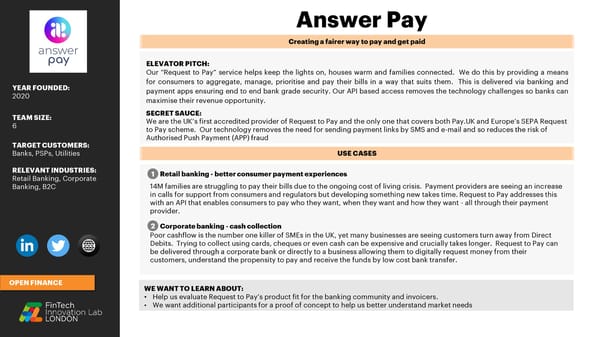Answer Pay CCreatreating ing a fa faireairer r wway ay tto o pay andpay and ggetet paipaidd ELEVATOR PITCH: Our “Request to Pay” service helps keep the lights on, houses warm and families connected. We do this by providing a means YEAR FOUNDED: for consumers to aggregate, manage, prioritise and pay their bills in a way that suits them. This is delivered via banking and 2020 paymentappsensuringendtoendbankgradesecurity.OurAPIbasedaccessremovesthetechnologychallengessobankscan maximisetheirrevenueopportunity. TEAM SIZE: SECRET SAUCE: 6 We are the UK’s first accredited provider of Request to Pay and the only one that covers both Pay.UK and Europe’s SEPA Request to Pay scheme. Our technology removes the need for sending payment links by SMS and e-mail and so reduces the risk of Authorised Push Payment (APP) fraud TARGET CUSTOMERS: Banks, PSPs, Utilities USE CASES RELEVANT INDUSTRIES: 1 Retail banking -better consumer payment experiences Retail Banking, Corporate Banking, B2C 14M families are struggling to pay their bills due to the ongoing cost of living crisis. Payment providers are seeing an increase in calls for support from consumers and regulators but developing something new takes time. Request to Pay addresses this with an API that enables consumers to pay who they want, when they want and how they want - all through their payment provider. 2 Corporate banking -cash collection Poor cashflow is the number one killer of SMEs in the UK, yet many businesses are seeing customers turn away from Direct Debits. Trying to collect using cards, cheques or even cash can be expensive and crucially takes longer. Request to Pay can be delivered through a corporate bank or directly to a business allowing them to digitally request money from their customers, understand the propensity to pay and receive the funds by low cost bank transfer. OPEN FINANCE WE WANT TO LEARN ABOUT: • Help us evaluate Request to Pay’s product fit for the banking community and invoicers. • We want additional participants for a proof of concept to help us better understand market needs
 FIL 2023 Cohort Booklet Page 21 Page 23
FIL 2023 Cohort Booklet Page 21 Page 23